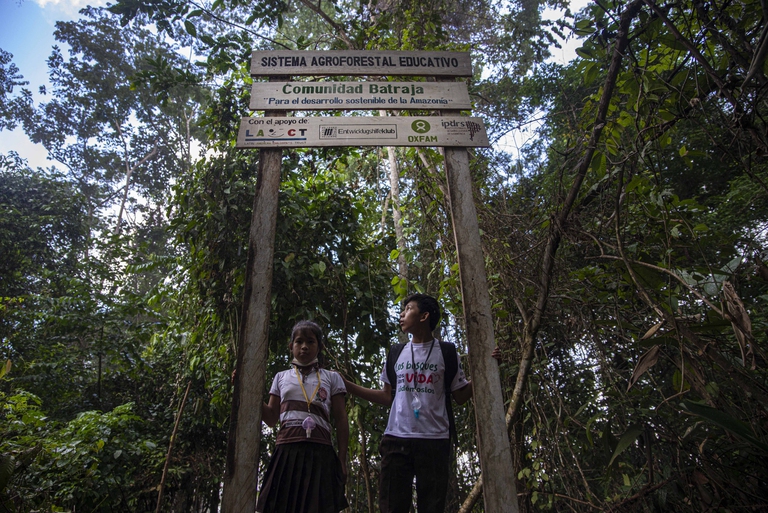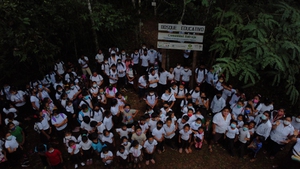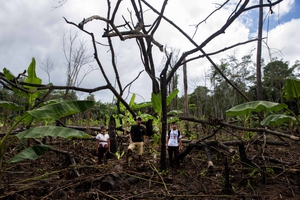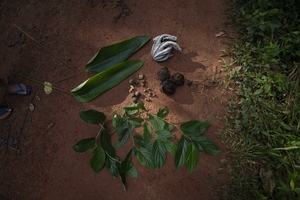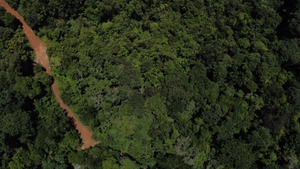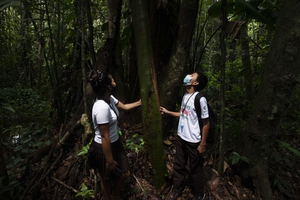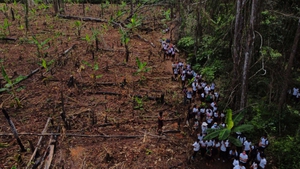
Our species took its first steps in a world covered in trees. Today, forests offer us sustenance, shelter, and clean the air that we breathe.
The Amazon became an alternative classroom during the pandemic. Now, the educational forest in Batraja, Bolivia, lives on to teach children and adults the value of nature.
Siblings Yuliana and Junior Valverde Choque, respectively 11 and 13 years old, walk around this part of the Amazon which their village of Batraja in Bolivia has designated an educational forest with the support of the Institute for Rural Development in South America and the NGO Oxfam. “It’s a forest for children and adults to visit to get to know the trees and species,” Junior explains. “Because often people don’t know the name of trees or what their fruits can be used for”.
It’s a forest for children and adults to visit to get to know the trees and species.
Batraja is located in the department of Pando in the northern part of Bolivia, close to the border with Brazil. Walking through the forest, Yuliana and Junior point out the different trees and explain about their medicinal uses. “When you cook the leaves from this tree, you get a remedy which helps against malaria,” Junior explains. “Our father has had that. There’s a lot of malaria around here. We learned about this tree and the remedy from the educational forest”.
The village began to operate the educational forest at the end of last year and it served well as an alternative classroom during the pandemic. The teachers had left the village due to the threat of Covid-19, so Yuliana and Junior’s father, Luis Gabriel Valverde Mapo, 38, became the new improvised teacher, holding classes with the children in the forest.
“Teaching the kids about the environment and climate change has been really valuable,” he says. “We live here in the Amazon but sometimes we disregard our forest. So with this initiative we’ve had our knowledge strengthened. We’ve also been teaching about the management of natural resources and the value of nature”.
“It’s beautiful what we’re doing here,” he continues. “Often we talk a lot about the serious destruction of the Amazon. It’s beautiful to see people who are working to change that mentality and take care of the forest. We’re still in time to take care of it. If we’re not doing it, then who will? That is our task, us living here in the Amazon. If we cut down the forest, we’ll be the ones affected. And to be able to take care of it we must be informed about the importance of nature. We’re still in time to conserve our forests, the plants, the animals, everything”.
If we cut down the forest, we’ll be the ones affected. And to be able to take care of it we must be informed about the importance of nature. We’re still in time to conserve our forests, the plants, the animals, everything.
Luis Gabriel’s words ring true, backed up by the latest data. According to Global Forest Watch, the loss of primary forests increased by 12 per cent in 2020. Brazil topped the list and Bolivia was in a sad third place out of the countries with the highest rates of deforestation.
Returning to Yuliana and Junior in the forest, the soundscape is filled with an intense orchestra of different insects. Asked about their favourite trees, the young siblings don’t hesitate to answer and show them. “My favourite tree is the acai because its fruit contains many vitamins,” says Yuliana while pointing at the palm carrying the valuable fruits sold worldwide as a superfood. On another occasion, we’re able to witness a brave acai harvester climbing many meters up the tree’s thin trunk to reach the small fruit. An impressive technique implemented with great ease.
“My favorite is the Brazil nut tree,” says Junior. It contains vitamins and helps support families around here”. Brazil nut harvesting is by far the most important economic activity in this area, another example of an environmentally sustainable economic activity related to the forest. Junior also points out another tree that had a similar role around here in the past, the rubber tree.
The children’s enthusiasm highlights how essential the economic role of the forest is – deciding between deforestation and conservation can be complex for local populations who must care of their livelihoods too. Yuliana and Junior’s mother Grecia Choque Villanueva, 32, is worried about external threats to the forest. “Earlier most people would dedicate themselves to cutting down trees illegally,” she recalls. “That is why such a big part of the Amazon is deforested. People would cut down cedar, mara and oak and they would sell that for exportation. It’s also important to reforest so that future generations can enjoy nature as well. Sometimes, economic necessity leads people to illegal business“.
Returning to the jungle, Junior point out another plant. “This one is palo santo. It is also a natural remedy, it works against pain, for instance pain in the bones. We’ve learned that we must take of the forests, not contaminate them, not cut down trees or burn garbage,” he adds. “Then we would be destroying Mother Earth. We should prevent climate change. We’re feeling the climate change, it gets a lot warmer around here now”.
The educational forest has been a learning experience for all in Batraja, says father Luis Gabriel. “Now the students know that our forests need to be taken care of to function well. We still have clean air around here thanks to the forest. Nowadays the whole community is relating more to the forest and giving it more importance. I really have seen a change here”.
Yet he too is increasingly worried about climate change. “The past years the temperature has gotten high here, up to 39 degrees [Celsius]. It gets so warm, we can hardly work. Also, what you sow won’t grow anymore because of the strong heat. We know that it’s related to the big fires. It’s important that we don’t burn and that the creeks continue filling up like before because in the dry season we have little water”.
The educational forest in Batraja has become so popular that neighbouring villages have shown interest and want to develop their own. Yuliana and Junior also spread the word to others. “We’ve learned the importance of taking care of the forest, the trees and not killing animals,” says Yuliana. “We talk with other people, friends of the family and so,” her brother adds. “We tell them about what the plants and trees are good for. That we must learn to take care of them. In general, they don’t know a lot about that”.
Their father has become ever more convinced of the importance of the educational forest. “I wish that everyone, adults and children, learn about the value of nature. And that they also teach other people and the next generations. We must give value to all that knowledge that the forest holds so it becomes a custom. If we don’t make it a tradition, we’ll just continue on the same as always”.
This report was produced with support from Oxfam in Bolivia.
Siamo anche su WhatsApp. Segui il canale ufficiale LifeGate per restare aggiornata, aggiornato sulle ultime notizie e sulle nostre attività.
![]()
Quest'opera è distribuita con Licenza Creative Commons Attribuzione - Non commerciale - Non opere derivate 4.0 Internazionale.
Our species took its first steps in a world covered in trees. Today, forests offer us sustenance, shelter, and clean the air that we breathe.
Bangladesh suffered widespread damage as a result of Cyclone Amphan. Yet the Sundarbans mangrove forest acted as a natural barrier protecting the country from further destruction, as it has done countless times before.
On top of a 2.4 million dollar compensation, the indigenous Ashaninka people will receive an official apology from the companies who deforested their lands in the 1980s.
The tapir was reintroduced into Brazil’s Atlantic Forest, the country’s most at-risk ecosystem. The species can play a key role in the forest’s recovery.
Forests are home to 80 per cent of the world’s terrestrial biodiversity. This year’s International Day of Forests highlights the urgent changes needed to save them.
After a legal battle that lasted two years, Indonesia’s Supreme Court has revoked the permit to mine for coal in the forests of South Kalimantan in Borneo.
The list of human and animal victims of the Australia wildfires keeps growing – one species might already have gone extinct – as the smoke even reaches South America.
Areas where the FARC guerrilla used to hold power in Colombia have faced record deforestation. Farmers cut down trees, burn land and plant grass for cows. Because, “what else can we do for a living here in the Colombian Amazon”? An intimate report from the heart of the felled forest in Caquetá.
Refusing the anthropocentric vision and respecting the laws of ecology is the only way to safeguard the future of our and all other species, Sea Shepherd President Paul Watson argues in this op-ed.
